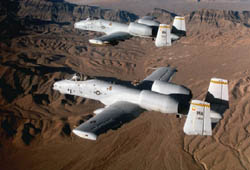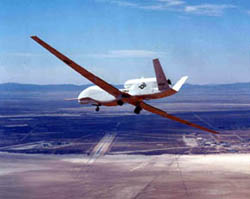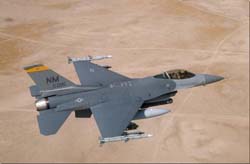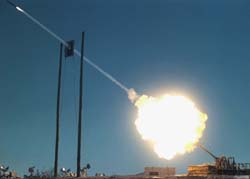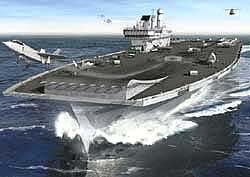Page 1
Daily News
By Gail Helmer
| Send Us News | Archives | Main |
Thursday June 27, 2002
PC News
- LO:MAC Producers Journal
- America's Army to Launch July 4
- A-10 Crashes in France, Two Dead
- Global Hawk Reaches 1,000th Combat Flight Hour
- USAF F-16s Updated With 'Smart' Weapons Capability
- Raytheon Conducts World's First ERGM Flight Test
- BAE Systems Announces Its Future Carrier Strategy
- Command Merger For US Missile Capabilities
LO:MAC Producers Journal
Matt Wagner, Producer Ubi Soft, has posted his latest Producers Journal regarding the development of Lock On: Modern Air Combat. Here is an interesting excerpt:
One area of the game that has generated a lot of questions is the Dynamic Battle Generator. Unfortunately, the key programmer responsible for this feature has left the developer for other career opportunities. This makes it unreasonable to expect that we would be able to complete the DBG as originally planned in the time remaining. As such, we have been evaluating a new dynamic campaign system that, in many ways, would be more powerful and more expandable than the original DBG system. However, until we have fully evaluated this alternate campaign engine and have solidified the design details, I'm afraid I can't go into any more detail at this time. Suffice to say though that we remain determined to have an immersive, player-configurable, campaign with unlimited replay ability.[More...]
America's Army to Launch July 4
The United States Army has announced that Operations, the tactical first-person shooter half of America's Army, will be available for download on July 4, 2002. The team-based shooter can support up to 32 players per game. The game is built on Epic's latest Unreal 3D engine, and it will include 20 single- and multiplayer missions. It will have training missions such as navigating an obstacle course and parachuting, and those missions are a prerequisite to joining the multiplayer missions. In the multiplayer matches, both teams will perceive that they are on the US team. Communication will also play a large role in the game, and players will be able to send messages to their teammates using speech, whispers, shouts, radio messages, and hand and arm signals.
Soldiers, the role-playing half of America's Army, is scheduled for release later this summer. It will take players through training and adventures that involve tactical, technical, and physical challenges similar to experiences soldiers might have on their first tour of duty both on and off duty. The Army plans to distribute both halves of the game for free over the Internet.
Military News
A-10 Crashes in France, Two Dead
A U.S. military aircraft crashed on Thursday in a wooded region of eastern France, killing the two people on board, the local government office said. The A-10 "Warthog" ground attack plane crashed at 2:45 p.m. in the Vosges region between Domptail and Saint-Pierremont, near the town of Rambervilliers, an official said. There were no other casualties. It was not immediately known why the aircraft was flying over the Lorraine region or what caused the crash.
Global Hawk Reaches 1,000th Combat Flight Hour
Northrop Grumman Corporation's Integrated Systems sector announced today that its RQ-4A Global Hawk unmanned reconnaissance system reached 1,000 combat flight hours June 15 in service with the U.S. Air Force in support of Operation Enduring Freedom.
Flying overseas with the Air Force since last fall, the high-altitude, long-endurance system achieved the milestone through the exceptional performance of multiple air vehicles. Global Hawk is in engineering and manufacturing development and low-rate initial production.
"The Air Force showed great confidence in the Global Hawk system by calling it into service to support Operation Enduring Freedom," said Carl O. Johnson, Integrated Systems vice president and Global Hawk program manager. "Achieving 1,000 flight hours demonstrates the reliability of this autonomously controlled unmanned system.
Global Hawk is a high-altitude, unmanned aerial reconnaissance system that operates autonomously from takeoff to landing. Flying at an altitude of 65,000 feet and with an endurance of more than 30 hours, the Global Hawk provides intelligence, reconnaissance, and surveillance information to the warfighter in near real-time. The program is currently contracted by the Air Force. The U.S. Navy also plans to procure Global Hawk to demonstrate maritime surveillance capabilities to the fleet.
USAF F-16s Updated With 'Smart' Weapons Capability
The U.S. Air Force recently began using a software update developed by Lockheed Martin Aeronautics Co. that will add a new "smart" weapons capability to its 400-aircraft fleet of Block 40/42 F-16C/Ds.
Smart weapons provide the ability to conduct precision attacks in all weather and avoid intense threat defenses near the target. The new smart weapons enabled for use by the software update are:
"This is the sixth software update for USAF's Block 40/42s, and the seventh is well along in development," said William J. Lake, director of U.S. Air Force and European Participating Air Forces F-16 programs at Lockheed Martin Aeronautics. "USAF has challenged us to produce software updates about every two years for each block in the USAF F-16C/D fleet, and this is keeping the F-16 current with the latest developments in weapons capabilities."
- GBU-31 Joint Direct Attack Munition (JDAM) - INS/GPS (inertial navigation system/global positioning system [satellite]) guidance
- AGM-154 Joint Stand-Off Weapon (JSOW) - INS/GPS guidance
- CBU-103/104/105 Wind-Corrected Munitions Dispenser (WCMD) - INS guidance
- EGBU-27 enhanced laser-guided bomb - laser seeker plus INS/GPS guidance.
In addition to the new weapons, the software update includes improvements to the APG-68 multimode radar operation, AIM-120 Advanced Medium Range Air-to- Air Missile (AMRAAM) display symbology, digital terrain system capabilities, and data link functions. The update also includes numerous cockpit mechanization improvements that will enhance pilot situation awareness and efficiency in the tactical environment.
The new weapons capability and other improvements are integrated with only software changes to the aircraft's core avionics and no hardware changes to the aircraft. The software is installed on the aircraft at the base level in a matter of minutes, without removing any components.
Eventually, after receiving the F-16 Common Configuration Implementation Program (CCIP) major upgrade, USAF Block 40/42s and 50/52s will have common core avionics and software. The CCIP modification to the first Block 50/52 aircraft was completed in January 2002, and the first Block 40/42 is scheduled for the CCIP upgrade in 2005.
The F-16, the world's most sought-after fighter, is the choice of 22 countries. More than 4,000 aircraft have been delivered, hundreds more are on order for the United States and six other countries, and production is expected to continue beyond 2010. Major upgrades for all F-16 versions are being incorporated to keep the fleet modern and fully supportable over the aircraft's long service life.
The F-16 is playing a major role as the durable and versatile "workhorse" in allied peacekeeping operations in the Balkans and Iraq. The F-16 is a key player in Operation Noble Eagle, homeland air defense of the United States, and recently participated in Operation Enduring Freedom in the war on terrorism in Afghanistan.
Raytheon Conducts World's First Gun-Launched Guided Projectile Flight Test
In a first-of-a-kind test, Team ERGM successfully fired a precision guided projectile from a representative gun system and guided it to a designated target area June 25. The flight test exceeded tactical end-game accuracy requirements, and the test demonstrated terminal accuracy performance sooner than called for in the program's development plan.
Led by Raytheon Company and the Naval Surface Warfare Center Dahlgren Division, the All Up Round (AUR) guided flight of the Extended Range Guided Munition (ERGM) took place at White Sands Missile Range, N. M.
In the flight test, ERGM was launched from a representative Mk45 Mod 4 gun system, using a tactical propellant charge, and successfully executed navigation and guidance after global positioning system (GPS) acquisition. This flight test achieved all test objectives.
The projectile demonstrated proper navigation and guidance despite experiencing extreme G-forces during gun launch. The 18-megajoule propellant charge impacted the projectile like a 40 ton hammer traveling at 70 miles per hour, almost immediately accelerating the round to 1,875 mph. The test also demonstrated a flight range of 39 nautical miles in under four minutes time of flight and airframe stability and control with proper internal system operation.
This guided flight test successfully completed the subsystem and system level design validation tests of the ERGM guidance, control and propulsion systems. The final validation tests are planned for next year after introduction of the new unitary warhead. This marks the start of ground environmental and flight performance qualification testing phase, which is the precursor to fleet deployment.
"The real accomplishment in this test was demonstration of GPS acquisition and navigation over an extended range after a tactical gun launch, which we did flawlessly," said Brian O'Cain, Raytheon's ERGM program manager. "Unfortunately, range safety footprint constraints and the current gun position prevented us from stretching ERGM's legs and flying to a longer range target. With this launch energy and rocket motor we could have easily exceeded 50 nautical miles."
Other test objectives included demonstrating aerodynamic stability, proper telemeter operation, successful up-reference determination, successful roll stabilization, and proper command control option (flight restraint system) system response. These objectives were successfully achieved, as well.
BAE Systems Announces Its Future Carrier Strategy
BAE SYSTEMS today announced its strategy for the design and build of Future Carrier, the Heart of the UK's Future Force Projection Capability. Chris Geoghegan, BAE SYSTEMS Chief Operating Officer and Nigel Stewart, Managing Director of the BAE SYSTEMS Future Carrier Team, gave a full overview of the BAE SYSTEMS team's proposals and strategy for the design, engineering, build and through-life support of the Royal Navy's two new Future Carriers.
BAE SYSTEMS has assembled a unique team to deliver the Future Carrier capability to the UK Ministry of Defence (MoD) - Northrop Grumman, Lockheed Martin, , AMS, Vosper Thornycroft, Rolls-Royce, Babcock BES, Strachan & Henshaw, Fleet Support Ltd., QinetiQ, BAE SYSTEMS Marine and Swan Hunter.
Team Commonality with partners Lockheed Martin, Northrop Grumman, Vosper Thornycroft and Rolls-Royce across other force projection elements - such as the Type 45 Anti-Air Warfare Destroyer, the Joint Combat Aircraft (the Lockheed Martin F-35 Joint Strike Fighter) and a possible Maritime Airborne Surveillance and Control (MASC) solution - brings the benefits of synergies, efficiencies, familiarity in working relationships, and confidence in the sharing of confidential data.
BAE SYSTEMS is working closely with its Future Carrier partners to bring creativity and innovation into the design of the carriers. This includes innovative hull and island designs, as well as systems such as automated weapons and munitions handling. Innovation also includes the use of commercial off-the-shelf (COTS) components and the application of technology from other programmes, such as the Type 45 Destroyer and from other industries, such as commercial aviation and commercial shipbuilding. This innovative approach ensures that the solutions chosen add real value for money through life.
Nigel Stewart, Managing Director of the BAE SYSTEMS Future Carrier team said: "We have invested heavily in prime contracting in the UK over recent years. Through experience and learning we have created a solid foundation on which to build, giving us a unique blend of skills, knowledge, and innovative thinking to be able to deliver successfully the Future Carrier project. Building on this, Future Carrier will provide new levels of skills and knowledge which will help us to grow our export base, essential to protecting the long term future of our industry."
The integration of Future Carrier with its associated force projection elements is central to the BAE SYSTEMS approach. The recent reorganisation of the company has established the C4ISR division, concentrating on systems architectures both within a platform and between platforms. The C4ISR division, along with AMS, is playing a key role within the team developing integrated solutions and capabilities for the Future Carrier.
Chris Geoghegan, BAE SYSTEMS Chief Operating Officer said: "Future Carrier is a defence procurement of the highest political significance, key to the UK's overall defence infrastructure. It must be integrated in command, control and interoperability terms with a variety of other platforms. Consequently, the BAE SYSTEMS approach sets Future Carrier in the broader context of an integrated Force Projection system and a coherent industrial strategy. This will provide the best value for money for the UK and is in the best interests for our country in the long term."
Command Merger For US Missile Capabilities
The Defense Department will proceed with the merger of U.S. Space Command and U.S. Strategic Command, Defense Secretary Donald H. Rumsfeld announced June 26. The merger of the two unified commands is part of the Bush administration push to transform the U.S. military to make it more responsive and flexible. The new command is slated for initial operational capability on Oct. 1, 2002.
The preferred location for the new, as-yet unnamed command is Offutt Air Force Base, Neb. Offutt is currently home of Strategic Command. Space Command is based at Peterson Air Force Base, Colo. Department of Defense (DoD) officials said some small number of people would transfer from Peterson if the Offutt location is approved.
Strategic Command is the command and control center for U.S. nuclear forces. Space Command handles U.S. military space operations, information operations, computer network defense and space campaign planning.
President Bush has approved the plan. The new command "will be responsible for both early warning of, and defense against, missile attack as well as long-range conventional attacks," Rumsfeld said during a press briefing.
In April, Rumsfeld and Air Force Gen. Richard Myers, chairman of the Joint Chiefs of Staff, announced changes to the Unified Command Plan that established U.S. Northern Command and made other changes to boundaries and responsibilities for combatant and unified commanders. At the time, they said DoD was studying the merger of the two commands.
Rumsfeld said the missions of the two commands have evolved to the point where a merger into a single entity would eliminate redundancies in the command structure and streamline decision making.
Myers said he is "very comfortable" with the proposal. "The merger should, and in my view, definitely will increase the military effectiveness providing the appropriate support to our combatant commanders around the world and, for that matter, responsiveness to the president and to the secretary of defense."
Myers said other proposals -- most notably the merger of the new Northern Command with Southern Command -- are being looked at, but nothing is in the works now.
"We think overall on the Unified Command Plan we have taken steps in the last six months, especially with the SPACECOM and Strategic Command merger, we have made some very, very big changes in the Unified Command Plan," Myers said. "I guess we're thinking we probably ought to let this settle out for a little bit before we tackle some more big issues."
About 600 service members and 300 civilian employees are currently at Space Command, while Strategic Command has about 1,500 military and civilian employees.
| Send Us News | Archives | Main |
